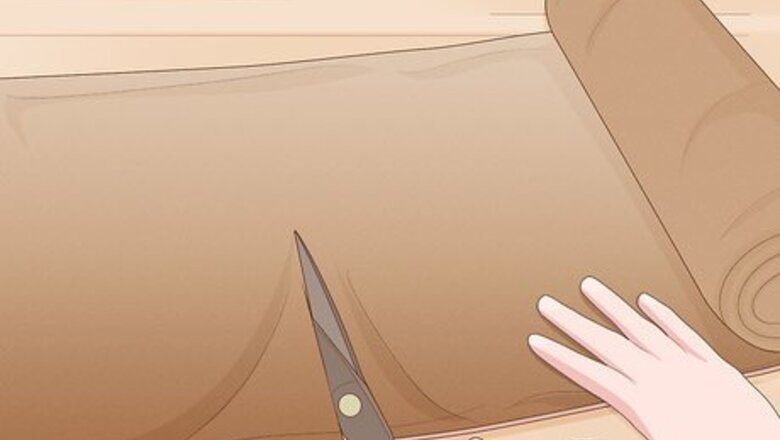
views
Casing Leather and Tracing on Your Design
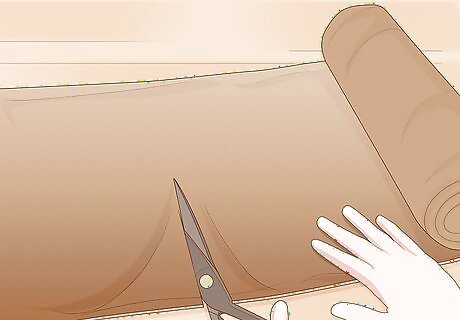
Purchase a large piece of naturally tanned leather. Visit a local hobby or leatherworking store and take a look at their naturally tanned leather selection. Light-colored leather is easier to carve than dark leather, especially for beginners. The cuts and impressions you create will be more visible on light leather. For best results, look for vegetable-tanned or oak-tanned leather. Chrome-tanned leather is usually a bad choice and is difficult to work with. The surface is too water-resistant and too soft to hold a carved design. It’s possible to tan your own leather, but the process is complex and time consuming. If you’re new to leather carving, it’s best to buy a piece of already-tanned leather.
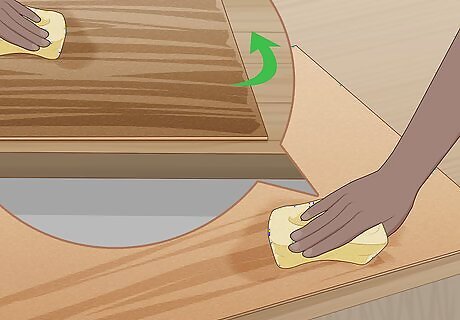
Use a moist sponge to wet both sides of the leather. Run an ordinary sponge under your kitchen tap until it’s damp. Squeeze it to wring out excess water and wipe the sponge over both sides of the piece of leather. The piece needs to slightly moist all the way through, but it should not be soaked. This process is known as “casing” the leather. After the leather dries to its original color, it will be slightly moist, flexible, and ready to work with. Alternatively, you can quickly dunk the leather in standing or running water, but you should only submerge it for 1–2 seconds. Leather that is too wet will become too soft to hold carvings. On the other hand, leather that is too dry can crack when you attempt to carve it.
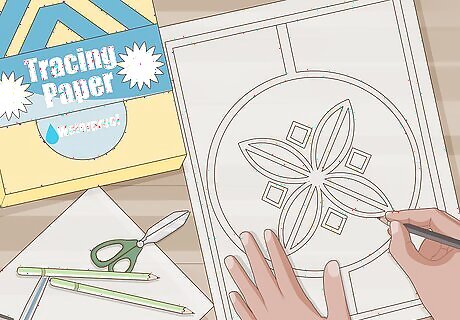
Draw a pattern onto waterproof tracing paper or wax paper. Use a pencil—and a ruler, protractor, or whatever other tools you need—to trace out your desired pattern. Depending on your artistic skill and the difficulty of the pattern, you can draw a freehand pattern or trace a pattern from another source. If you’re using actual tracing paper (not wax paper), keep the matte side of the paper facing up. Draw your lines very lightly, so you can erase any errors you may make.
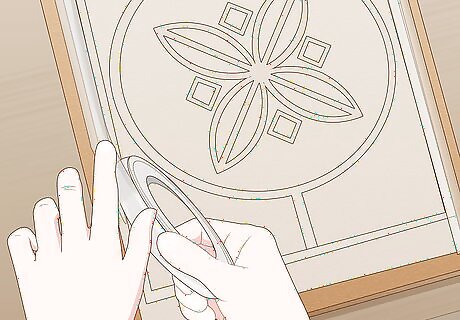
Tape the prepared pattern on the back side of your leather. Set the tracing (or wax) paper so that the traced side of the paper faces up. Tape the tracing paper down on the leather to prevent it from shifting as you copy the design. Although you can use any type of tape you have on hand, transparent tape is the best option. It has a weak enough adhesive that it won’t damage the leather. Do not tape the tracing paper to the front of the leather! Doing so could ruin the tanned leather and cause you to have to start the process over. You can also cut out the leather pattern with a pair of scissors.
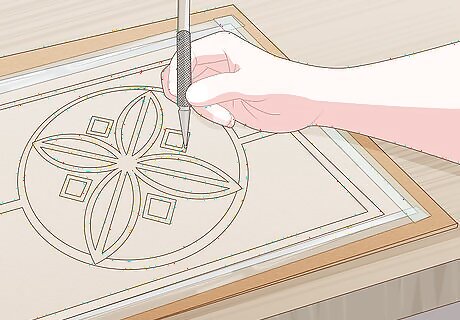
Trace the pattern onto the leather with a dull stylus. Once your paper template is firmly taped to the back of the leather, pick up a stylus and set its tip on 1 of the lines you’ve drawn. Trace over all of the lines on the template to impress the design into the leather. As you trace, apply constant, gentle pressure over each line of the pattern so that all of the lines are evenly pressed into the leather. Remove and dispose of the paper once you’ve finished tracing the design. You can also outline the pattern on the leather with a white marker.
Cutting and Shaping the Lines
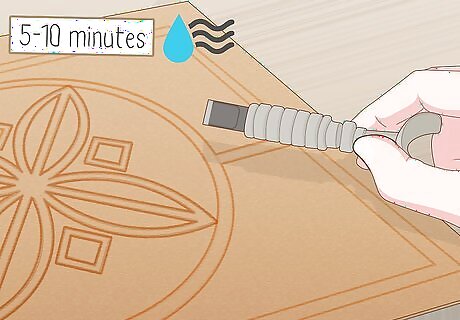
Begin carving immediately after you’ve traced the design on the leather. Once you’ve cased the leather and transferred the design, immediately begin to carve the piece. Waiting more than 5–10 minutes before you start carving will allow the leather to dry out too much. You can moisten the piece of leather again if it does dry out, but doing so too often can make the leather more difficult to carve. If you do need to step away at any point during the carving process, place the leather in a resealable plastic bag to help it retain moisture. For longer breaks—say, more than 9 hours—allow the leather to dry, then moisten it again when you are ready to resume work.
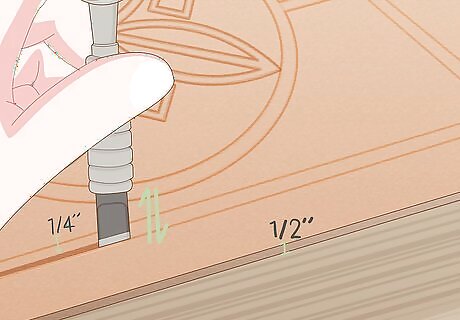
Carve each line into the leather with a swivel knife. Take a swivel knife and hold it straight up-and-down with your index finger in the U-shaped dip at the top. Trace the tip of the knife blade over each line of the pattern that you impressed on the leather. Maintain consistent pressure for every cut so that all of the carved lines have a similar depth. Each cut should be roughly half the thickness of the leather itself. For example, say that you’re working with a piece of leather that’s ⁄2 in (1.3 cm) thick. Aim to cut each line only ⁄4 in (0.64 cm) thick. A swivel knife is the ideal kind of knife to use when cutting leather. While you could use a utility knife, it’s inadvisable, since you’ll likely end up with an uneven cut.
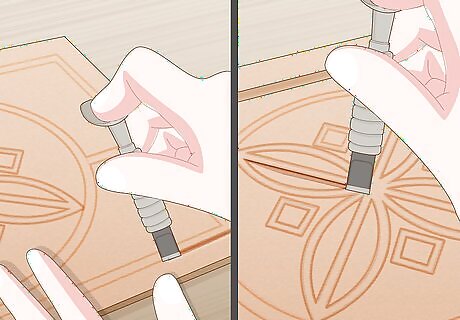
Cut outside border lines and foreground lines first. If you’re carving a complex design, begin by carving in the lines that represent the border of the design. If your design has a subject and a background, first carve the foreground lines and cut the background lines second. If you carved the background first, you might accidentally cut outside of the border or make an unsightly line through the foreground. For lines that do not end at another line, gradually apply less pressure toward the end of the line to taper it off.
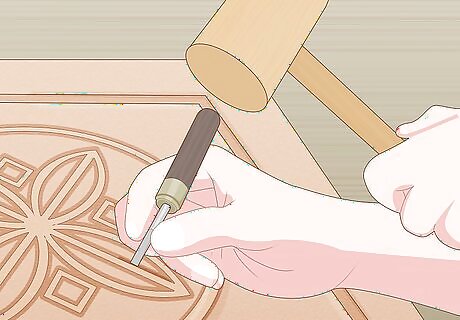
Round and shape the lines you’ve carved with a beveler. Hold the beveler vertically. Place the deepest part of the wedge tip inside the cut you’d like to widen. Lightly tap the back of the beveler with a mallet to smooth the edge of the line. Glide the beveler across all of the lines you’d like to deepen, overlapping the previous stroke by about two-thirds of its full length, until the entire line is finished. Bevel lines in the order you created them. Start with the border before progressing to the foreground of the main design. Then work from the foreground to the background.
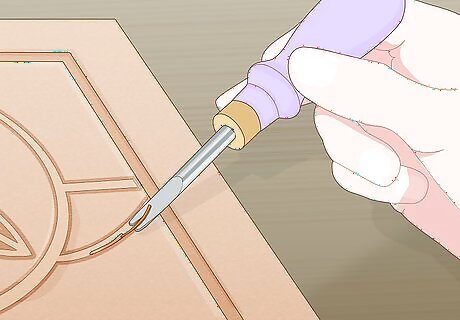
Cut large chunks out of the leather with a deep beveler. The end of the largest beveler tool has a sharp U-shaped blade that can cut out large chunks of leather. This is a great way to add shading and detail to your leather carving. Place the tip of the tool against the section of leather you’d like to cut out, and give the base of the beveler 3–4 taps with a hammer to cut through the leather. Use larger bevelers to carve deep, wide lines that are relatively straight. A beveler tool kit contains 5–7 different sizes of beveler blades. While the larger blades are great for removing large swaths of leather, smaller blades are great for more detailed work or cutting intricate curving lines.
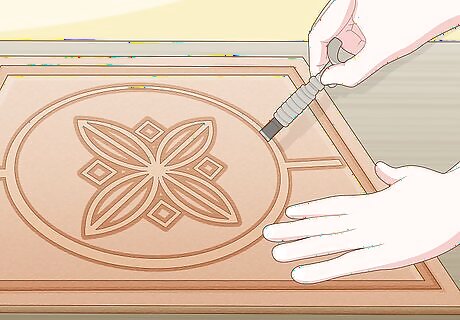
Make final decorative cuts using your swivel knife. When making a decorative cut, set the swivel knife vertically and carefully pull the knife toward you. Decorative cuts should be about half as deep as the primary cuts previously carved using the swivel knife. These cuts should also start deep and gradually get shallower as they move across the design to give it a finished, professional look. Decorative cuts should be the last carvings you make in a design. These cuts can be used to accent the design once all other textures and alterations are in place.
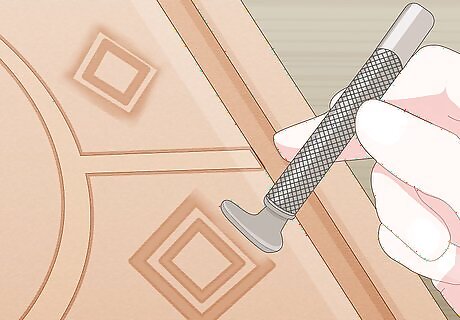
Smooth out any carving mistakes using a modeling tool. Tanned leather is a relatively forgiving substance to work with as long as you don’t wait too long to fix mistakes. Carefully run the spoon-shaped end of the modeling tool over the misplaced stamp. Apply even, light pressure. Doing so should polish away the mistakes, leaving smooth leather in their place. You can also use the modeler to round away hard edges in your design. Too much smoothing can blur the lines of the design, however, so do this carefully if you choose to do it at all. Spoon-style modelers can be used to correct minor mistakes made with stamping tools. You may also be able to fix mistakes in small decorative cuts made with the swivel knife.
Using Tools to Stamp the Leather
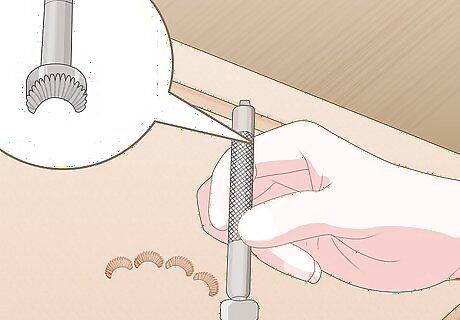
Apply mottled texture to the carved leather using a camouflage tool. Position the tool over the portion of the design you wish to enhance. The tool can be angled vertically or tilted in any direction, based on the effect you’d like to achieve. Gently tap the back of the tool with a mallet to stamp the texture onto the leather. The camouflage tool, also called a “cams,” produces a distinct texture similar to that of camouflage clothing. Cams are often used along the lines of stems and scrolls within a broader design. In these instances, the tool is generally tilted toward the line. Cams are often used to add texture to flower petals, too. Do not use a metal hammer with the cams tool—or with any of the other stamping tools—or you could end up damaging the stamp.
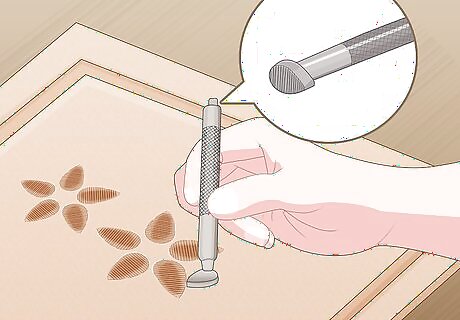
Use a pear shader tool to add dimension and visual texture. Position the shader over the desired area. As a general rule, you should hold it vertically when shading large areas and tilt the stamp toward its narrower end when shading a tightly enclosed area. Lightly tap on the shader with a mallet to apply the pattern and contour the surface of the leather. A pear shader is a great tool to use if you’d like to make some areas of your leather design appear darker or more shaded than others. The shader works by flattening areas of leather to make them appear darker and farther away from the viewer. When you need to shade an area that is larger than the face of the shader, move the tool across the surface roughly ⁄16 in (1.6 mm) after each strike. Continue as needed until the entire area is shaded.
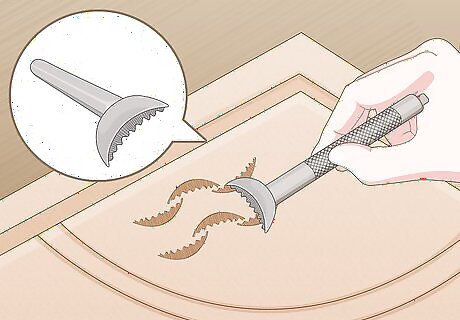
Stamp finely detailed veins on the leather with a veiner tool. Leatherworkers typically use the veiner tool to add intricate patterns to curving leaves, stems, and scrolls. Place the veiner against the leather in the direction you’d like the pattern to face, and give it 1–2 firm taps with a hammer. Then repeat the process by stamping the veiner tool along the rest of the leaf or scroll that you’re embellishing. Evenly space out the individual veiner stamps so that they curve along the design of the stems or scrolls you’ve carved into the leather. Try spacing separate impressions evenly apart by ⁄8 in (0.32 cm). Veiners come in a tremendous variety of curvatures, patterns, and shapes. Try out a few and see which you like best before selecting specific veiners to use on your leatherwork.
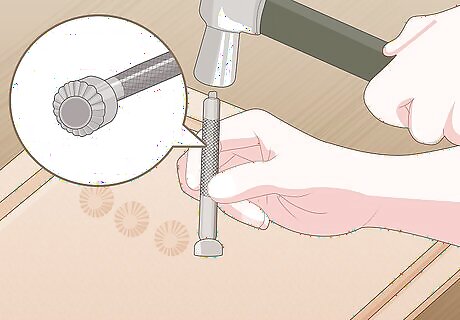
Indent round dots on the leather with a seeder tool. The seeder tool—one of the most popular leather stamps—creates perfectly round dots that look good as the center of flowers or as decorative scroll ends. Hold the seeder vertically and position the tip where you’d like the indented dot to be located. Give the end of the tool 3–4 firm taps with a hammer to make the mark on the leather. When using the seeder to fill in a blank space with circular dots, work around the perimeter of that space first, then gradually fill in the center.
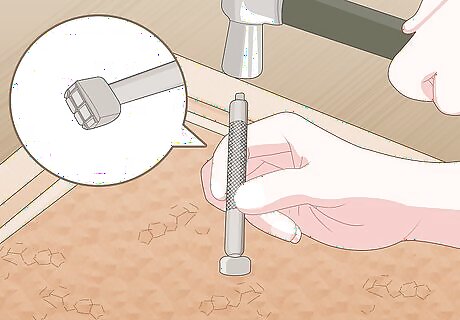
Flatten and texture background areas with a background tool. As its name suggests, the background stamp flattens out non-carved background areas of the leather design and gives them a finely detailed texture. Place the tool in the background of the design, and strike it lightly 2–3 times with a hammer to imprint the design on the background. Continue hammering the background design across your leather until the entire background has been flattened and textured. Work around the perimeter of the background first, then gradually walk the tool across the interior of the background, moving ⁄16 in (1.6 mm) at a time. Rotate the tool as you move it across the background to make the overall texture appear more even. Background areas usually include the gaps around enclosed shapes and designs.




















Comments
0 comment